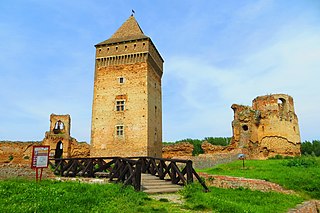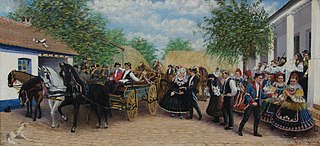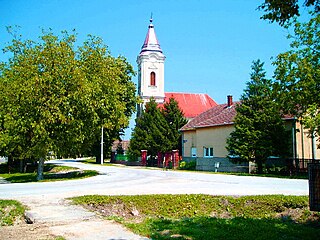
The South Bačka District is one of seven administrative districts of the autonomous province of Vojvodina, Serbia. Geographically it lies in the southern part of Bačka and northern part of Syrmia. According to the 2022 census results, it has a population of 607,178 inhabitants. The administrative center of the district is the city of Novi Sad, which is also the capital and the largest city of the Autonomous Province of Vojvodina.

Bački Petrovac is a town and municipality located in the South Bačka District of the autonomous province of Vojvodina, Serbia. The town has a population of 5,227, while the municipality has 11,512 inhabitants.

The dominant religion in Vojvodina is Orthodox Christianity, mainly represented by the Serbian Orthodox Church, while other important religions of the region are Catholic Christianity, Protestant Christianity, Islam, and Judaism.

Serbia has been a predominantly Christian country since the Christianization of Serbs by Clement of Ohrid and Saint Naum in the 9th century. The dominant confession is Eastern Orthodoxy in the fold of Serbian Orthodox Church.

Maglić or Bački Maglić is a village located in the Bački Petrovac municipality, in the South Bačka District of Serbia. It is situated in the Autonomous Province of Vojvodina. Of the 2,695 population of the village, 2,426 are ethnic Serbs.

Selenča is a village in Serbia. It is situated in the Bač municipality, South Bačka District, Vojvodina province. The village had a population of 2,996 according to the 2011 census, with an overwhelming Slovak ethnic majority.

Soljani are a village in Cvelferija in the southernmost part of Vukovar-Syrmia County. From the 2011 census the village had a population of 1241 inhabitants.
According to the 2022 census, Slovaks in Serbia number 41,730, constituting 0.63% of the country's population. They mainly live in Vojvodina (39,807), where they constitute the third largest ethnic group after Serbs and Hungarians. Like other ethnic Slovaks, they speak the Slovak language, but most of them are Protestant by faith and not Roman Catholic, unlike most Slovaks in Slovakia.
Protestants are the 4th largest religious group in Serbia, after Eastern Orthodox Christians, Roman Catholics and Muslims. In the 2011 census, there were 71,284 Protestants in Serbia and they comprised 1% of the population of the country. Ethnic Slovaks constitute majority of Serbia's Protestant community. Some members of other ethnic groups are also adherents of various forms of Protestant Christianity.

Salaš is a traditional type of property in the Pannonian Plain region, particularly in Bačka and Slavonia, with a family house and agricultural objects such as a barn, stable and granary, surrounded by arable land and pastures. They were owned and inhabited by a single family, who lived there for generations. Western equivalents to the salaš are ranches and cottages.

Pavel Marčok is a politician in Serbia from the country's Slovak community. He was a member of the National Assembly of Serbia from 2007 to 2012 and was the mayor of Bački Petrovac from 2012 to 2016. During his political career, Marčok was a member of the Democratic Party.

The 9th Summit of the Non-Aligned Movement on 4–7 September 1989 in Belgrade, SR Serbia, SFR Yugoslavia was the conference of Heads of State or Government of the Non-Aligned Movement. Belgrade was the first city to host the Summit for the second time after it hosted the 1st Summit of the Non-Aligned Movement in 1961. Yugoslavia was unanimously selected as the host of the Summit at the 1988 Non-Aligned Foreign Ministers Conference in Nicosia, Cyprus. While the Federal Secretary of Foreign Affairs of Yugoslavia led by Budimir Lončar was excited, the Presidency of Yugoslavia, Yugoslav collective head of state, was skeptical about the prospects of hosting the event but ultimately supported it by Josip Vrhovec in fear that rejection may show the level of the crisis in the country. The comparatively weak federal government organizers of the event ultimately hoped that the conference may convince leaders of the strong Yugoslav federal republics to resolve the early Yugoslav crisis in a constructive and peaceful way, yet it nevertheless escalated in 1991 Yugoslav Wars. The event is therefore sometimes described as the swan song of the prominent Yugoslav Cold War diplomacy. Summit took place at the Sava Centar in New Belgrade. Janez Drnovšek held the opening remarks in Slovenian language.

Daniel Piksiades was a Yugoslav and Serbian poet of Slovak origin. He was the author of poetry collections in Slovak, Serbian and Croatian, and has been translated into many world languages. He was a member of the Association of Writers of Serbia, Slovakia, Vojvodina and Montenegro.
Borisz Bájity is a Serbian politician from the country's Hungarian community. He is a delegate in Serbia's Hungarian National Council and has served in the National Assembly of Serbia since February 2024. Bájity is a member of the Alliance of Vojvodina Hungarians (VMSZ).

The Ján Kollár Gymnasium and Students' Home in Bački Petrovac in Vojvodina, Serbia, founded in 1919, is a public coeducational high school serving primarily communities of Slovaks in Serbia and the rest of the former Yugoslavia region. Initially established by evangelical priest Samuel Štarke and Julius Kubanyi, the gymnasium overcame early challenges, including the threat of closure due to lack of infrastructure, by constructing its building through voluntary contributions and support from Czechoslovakia and overseas Slovaks. The institution experienced growth in the interwar period in the Kingdom of Yugoslavia, developing educational facilities and a library. During World War II in Yugoslavia, it served as a resistance center against fascism despite being formally closed. In the post-war period, the gymnasium saw a significant increase in student enrolment, founded a boarding school, and opened a Slovak teacher training school. In 1969, the first Serbian language department opened, and the school was renamed after Slovak poet Jan Kolar. The Students' Home section of the institution was opened in 1997.

The Museum of Srem in Sremska Mitrovica is the city institution focused on the research, preservation and presentation of historical objects and artifacts related to the Syrmia region. The museum was officially established in 1946 under the name of the City Museum of Sremska Mitrovica shortly after the end of World War II in Yugoslavia and the liberation from the Axis occupation of Vojvodina.

The Sombor City Museum in Sombor, Vojvodina, Serbia, is the city institution focused on the research, preservation and presentation of historical objects and artifacts related to the west Bačka region. The museum was founded in 1887 when the society received its first exhibition space and today it focuses on local history in the municipalities of Sombor, Apatin, Odžaci, Kula and Bač. It is a complex museum with around 40,000 exhibits divided into five categories: archaeological, numismatic, historical, ethnological, and art collections. The museum publishes the Annual Journal of the City Museum of Sombor.

The National Museum of Zrenjanin in Zrenjanin, Vojvodina, Serbia, is the city institution focused on the research, preservation and presentation of historical objects and artifacts related to Banat region. The museum, founded in 1911, has a permanent exhibition space of 1,200 m2, showcasing applied arts, recent history, and ethnology. It also features a pedagogical service, restoration workshop, and a specialized library with over 5,000 titles. The building of Finance Palace, constructed in 1893, is a protected cultural monument in the neo-Renaissance style. The museum has been housed in the building since 1966. The Zrenjanin National Museum was named the best museum in Serbia in 2006.

The Municipal Museum of Subotica in Subotica, Vojvodina, Serbia, is the municipal institution focused on the research, preservation and presentation of historical objects and artifacts related to the north Bačka region. The museum was originally founded in 1892 and was re-established in the aftermath of World War II in Yugoslavia in 1948 by the Subotica Municipal Assembly. The palace housing the City Museum was built by Dr. Mikša Demeter according to a design by the Vago brothers from Budapest. The building was designed and constructed in 1906.

The City Museum of Novi Sad founded in 1954, is a complex city museum focusing on Novi Sad's, capital of the province of Vojvodina in Serbia, development from its origins to the modern era. It consists of several departments, including Archaeology, History, Cultural History, Ethnology, and a Regional Gallery for contemporary art.





















